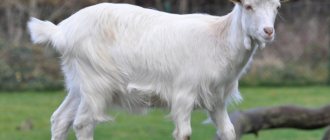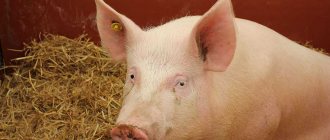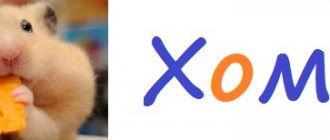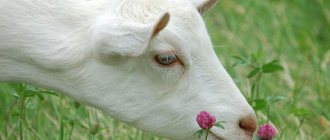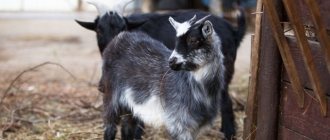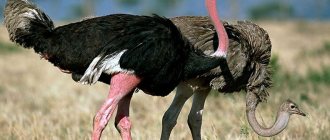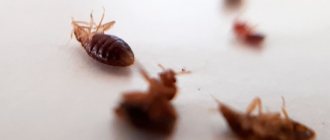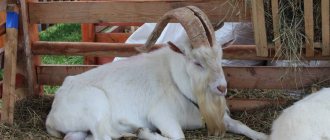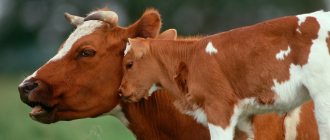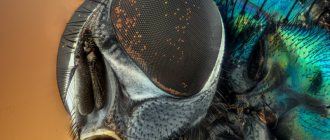Goats are seasonal animals. Their fertilization and lambing are closely tied to the changing seasons. To obtain offspring and milk, it is important to know how many days a goat walks and what the frequency of hunting is. Otherwise, you can miss the time of mating and be left without anything for a whole year.
A goat with a kid or is it still a goat?
Frequency and duration of hunting
Puberty in goats is early. Most individuals show the first signs of hunting already at five months of age. As a rule, this occurs at the end of August or beginning of September. A month before the expected hunting days, it is important to divide young animals into boys and girls and then keep them separately.
Early, unwanted insemination will interfere with the normal development of the goat's body. The offspring will be single. The kid is born small and lags behind breed standards in growth. In some cases, early lambing can lead to the death of the animal.
Goat hunting lasts several days. Occurs every three weeks. Animal behavior is changing. Signs of heat are not difficult to notice even for a novice goat breeder. How long a goat walks is determined by the time of year. In winter, the frequency of hunting increases by 3-5 days.
The duration of estrus ranges from 1 to 3 days. The best time for fertilization is the first 12-14 hours of hunting. Mating is carried out twice, in the morning and in the evening.
You can count how many times a goat walks a year. The seasonality of the fertile cycle is manifested in the fact that the goat “walks”, as a rule, from mid-August to the end of January - five months or 150 days. During this time, estrus occurs 6 to 7 times. From mid-winter to late summer, goats show no interest in males, reacting to their approach with aggression.
Artificial insemination
The best option for insemination is considered to be artificial insemination of goats. With this method, it is possible to control and select breeding goats with the best qualities and characteristics.
Artificial insemination is widely used on cattle farms. But goats lag far behind cattle. According to data, there are several goat seed banks in Russia:
- at the Institute of Gene Biology of the Russian Academy of Sciences, services are provided by the Golden Goat Association. For information about the provision of services, please contact [email protected] ;
- LLC "Innovations and Technologies in Animal Husbandry", Russia, Moscow region, urban settlement of Mytishchi, village of Fedoskino st. Vilyaminovskaya 72. Tel: +7-906-019-09-88, +7-993-333-38-85. Email
Video about artificial insemination of goats
How to recognize heat in a goat - the main signs
The arrival of mating time and how long the goat walks are determined by changes in the animal’s behavior.
What are the signs when a goat is walking:
- Refusal to eat. The goat may not eat the usual portion of feed, leave the hay, or refuse the treat. Not all animals do this, so you should focus on a set of signs. On the other hand, refusing to eat may indicate illness.
- Restless behavior. Signs of anxiety are identified by frequent (sometimes continuous) bleating when all basic needs are met. If the goat is healthy, fed, watered, and its environment has not changed, then most likely it is in heat.
- Wags his tail. A quick wag of the tail raised up almost always indicates the start of the hunt. The animal begins to wag its tail especially actively when it sees its owner. In this case, the general appearance of the goat can be defined as “begging.”
- Swelling of the vulva. If you look under the animal's tail, the vulva will be swollen, slightly pinkish and moist. During periods when the goat is not “walking,” its vulva is closed, dry, and the labia are folded inward. Here it is important to know what the genitals of a goat look like at rest.
- The goat "crouches". If you press your hands on the goat's back during a supposed heat, it will crouch down and raise its tail. In their normal state, goats react aggressively to such liberties, trying to wriggle out and run away.
It is impossible to say exactly how to understand that a goat is walking. This manifests itself differently in each animal. Some goats do not show clear outward signs of heat.
Baby goat with a hat
Why don't goats go into heat?
If there is a buck nearby, the absence of estrus may be due to a previous pregnancy. Goats only need one minute to mate.
A goat's lack of desire to mate may be due to several factors. Namely:
- Presence of worms. Periodic, once every six months, worming of goats is mandatory. Infection with parasites depresses the body and sharply reduces milk yield. The animal loses a lot of weight, but the goat’s appetite can remain good.
- Poor nutrition. The lack of vegetables, grains in the diet, and poor hay lead to exhaustion of the dairy goat. To compensate for this, the body postpones reproduction until better times.
- Short daylight hours when kept indoors.
- Obesity. An overweight animal either does not come into heat or is not fertilized during mating. In the second case, the goat walks several times.
The lack of hunting in a goat should cause concern among the owners. Perhaps the animal should be shown to a veterinarian or errors in caring for the goat should be corrected.
And what to do if the goat is not hunting?
- You should start by adjusting your diet. For fattened animals, grains are removed, with an emphasis on hay or grazing. Weak goats are fed with oats and bran, adding tetravit once a day.
- Check to see if the time for administering anti-parasite drugs has been missed. A veterinarian is invited to determine diseases.
- If you cannot determine how often the goats walk, then do a test mating. It is possible that your animals are in latent heat. This feature is passed on through the maternal line.
Mating
Insemination must begin immediately after determining the female's estrus. Goat breeders resort to several methods of mating goats, which vary in the degree of intervention by the breeder and are divided into 4 main types:
- Artificial.
This method involves manually inserting the male's semen into the vagina.
- Freestyle.
- Harem room.
- Manual.
- call a veterinarian to conduct a medical examination of the female and male;
- do not overwork the goat, as the process can exhaust him;
- do not force the goat to succumb to insemination if she runs away from the male and behaves aggressively;
- avoid family ties;
- use your own animals, and if you turn to foreign breeders, conduct a thorough check;
- After mating, give the goat a rest and let him approach the female again for copulation.
Goats and bucks mate in free conditions and choose each other.
One farm contains a large number of females and one inseminator, which can cover several dozen females.
The owner of the animals brings them together himself, fixing the goat using a special device.
In all cases, except artificial, where the participation of an inseminator is not necessary, the process occurs in the same way. Sensing the heat, the buck approaches the goat from behind and jumps on her, after which their genitals begin to copulate. After several movements, insemination occurs.
When preparing animals for mating, pay attention to the following recommendations:
Did you know? There is an option for artificial mating of females using donor material. Thus, in Turkey, in order to preserve the species of Angora goats, a sperm bank was created.
Stimulating a goat for hunting
- If the goat does not come into heat on time, but is healthy, then drug stimulation is used. Prescription of the drug and dosage are the responsibility of the veterinarian. In large farms, estrofan is often used for this purpose. Injections are given intramuscularly, 0.7 ml, morning and evening. Estrus occurs after 10 days.
- In private households, they limit themselves to tampons soaked in progesterone. They are inserted into the goat's vulva.
Note! It is impossible to use drug stimulation of oestrus if there is any doubt about the goat’s pregnancy. This leads to miscarriage.
Pathology
The following reasons for delayed labor are identified:
- Mummification of the fetus.
- Imaginary pregnancy.
Mummification of the fetus
The kid died, but conditions for its decomposition did not arise. Of course, the goat does not come into heat, but the condition may remain satisfactory. This situation persists for a year or more. The veterinarian may try to expel the dead embryo by administering an injection of Estrofan or Oxytocin and Synestrol. Most often, the animal is subject to culling.
Imaginary pregnancy
After sexual intercourse that does not result in insemination, the goat behaves as if she were pregnant. The belly enlarges, the female waddles, she begins to produce milk, which she sucks out herself or allows others to do this. Over time, the accumulated mucus or water drains away. Most often, such imaginary births go unnoticed. Reverse development occurs slowly, the owners continue to wait for lambing.
The pathology is caused by hormonal imbalances, which may recur in the next heat. You will have to part with such animals.
Suspicion of an imaginary pregnancy is confirmed or dispelled in the following way:
- During examination and palpation, fetal movement is noted.
- Listening reveals pulsations of embryos and uterine arteries.
Errors should not be excluded - the absence of entries in the record book or the registration of a mating that did not end in a successful insemination.
Therefore, goat farmers need to study the signs of lambing in order to prepare for the important event. Goat gives birth
Goat gives birth
How to induce heat in a goat without using medications
Not all owners agree to inject goats with hormonal medications. If there are no signs of estrus, then the goat can be stimulated as follows:
- Place the goat in the room overnight. Its smell has a stimulating effect on the female. At the same time, there is no need to let the animals get close to each other, since the active male will torture his “girlfriend.”
- Add sprouted grains, flax or soy to your daily diet.
- Increase daylight hours to 12 hours. This measure is necessary in late autumn and early winter.
- When making hay, some of it is rubbed on the skin of a goat to preserve the smell. Feeding such a supplement is a proven folk remedy for stimulating estrus in goats.
Where's my goat?
How many kids can one goat give birth to?
Goats are characterized by multiple pregnancies. One kid, as a rule, is born by young animals that are fertilized too early.
A mature female bears 2-3 kids without any damage to her health. A larger amount has a negative impact on the development of the offspring. The kids will be born small and weak. It often happens that one of them becomes unviable.
How to determine if a goat is pregnant
It is impossible to accurately determine pregnancy on your own in the early stages.
The main sign is the absence of another heat. 3 weeks after mating, you should carefully monitor the behavior of the goat. If the animal does not show concern, then, most likely, fertilization was successful.
There are some indirect signs of pregnancy that experienced breeders use. This:
- A noticeable increase in milk yield a couple of weeks after mating, followed by a sharp decline below the initial level.
- The covered female becomes calmer and lies down more.
- Asymmetrical belly. A noticeable increase in the abdomen occurs at 3-4 months. External examination does not give an accurate picture. The movement of the kids can be mistaken for the work of the goat's stomach.
- The vulva becomes enlarged and remains slightly swollen. However, its color does not change.
- An accurate result can be obtained early on by ultrasound.
When to expect offspring
If the mating was successful and the female managed to impregnate the goat, then offspring should be expected within five months. If mating does not produce the expected results, it should be repeated after three weeks, during the period when the individual resumes hunting. It is possible to determine that an individual is “in position” by the following signs:
- 21 days after mating there is no repeat estrus.
- The goat's appetite increases.
- The animal behaves calmly and reservedly, jumps and plays less.
- Instinctively protects the fetus - when the belly is touched, it presses it under itself and tries to recoil.
In order to confirm pregnancy, monitor the condition of the mother and fetus, as well as to select the necessary set of vitamin supplements, it is recommended to consult a veterinarian.
Sometimes, to control reproductive processes in the goat’s body, owners create a so-called “hunting calendar.” This event is carried out to monitor the frequency of estrus in the animal and their regularity. This can be a calendar in the literal sense of the word or a notebook in which the owner writes down the dates of estrus and mating, the frequency of hunting, and the timing of pregnancy.
Thanks to the right approach, any animal will not suffer, its health will remain unchanged, and the owner will receive an addition in the form of young goats.
Proper care of an animal after birth
A healthy goat lambs without human intervention. The kids appear one after another, with a break of a couple of tens of minutes. Veterinarians allow 4 hours to separate the placenta. Next, the goat’s uterus begins to close. Remains of the placenta can lead to the death of the animal.
If during this time everything does not work out, then you should help the goat by calling a specialist.
Forced separation of the placenta is carried out manually by inserting the hand into the uterine cavity. The animal must be in an upright position.
To stimulate uterine contractions, the goat is milked immediately after the kids emerge.
If the lambing is successful, the queen is given water with sugar and hay. The afterbirth is removed, the bedding is changed, and the animal is allowed to rest for an hour and a half. After which they offer clean water. You should drink at least once every 3-4 hours. Usually this time coincides with milking hours in the first 3 days. There should be hay in the feeder at all times.
Feeding after lambing is as follows:
- For the first 3-4 days, bran is given to stimulate the functioning of the stomach.
- From the fifth day, concentrates are added, introducing them in small portions.
- After a week, the goat is transferred to normal food. The daily diet of a dairy goat includes hay, branches, concentrated and succulent feed (raw vegetables).
- Milking goats is carried out with an increase in concentrated feed. They are given at least 3 times a day.
Note! You don’t have to worry about overfeeding a goat, since these animals, having had enough, leave what they haven’t eaten in the feeder.
Kids require no less attention during lambing. Necessary:
- Clear the mouth and nasal passages of any remaining membranes and amniotic fluid.
- Wipe off.
- Place in a warm place.
- Feed with colostrum.
- The frequency of feeding the kids coincides with milking the goat. In the first days after lambing, this is 4-5 times. After a week of intensive milking and feeding, you can switch to a three-times-a-day regimen.
Kids should be fed with fresh or warmed mother's milk. The offspring are not allowed near dairy goats even for a few days. To make the sucking reflex go faster, the kids are fed from a small container.
Baby goat for a walk
How to select a manufacturer? Finding a good goat
A goat “for breeding” must have distinct characteristics of the breed, be large and active. Sexual maturity in males occurs at 5 months. By autumn, the goat is quite ready to fulfill its purpose.
When purchasing, you should find out the purity of the offspring. In private farmsteads, related matings are often practiced, due to which the breed gradually degenerates.
Signs of a good sire (good goat):
- Short powerful neck.
- Neat head.
- Developed breasts.
- Wiry back.
- Short straight legs.
- Thick beard.
- Developed genitals.
- Height at the withers is about 80 cm.
- Weight about 70 kg.
A mature producer is used for about 4 months a year. The rest of the time he is on a maintenance diet. A month before the expected mating, the goat is transferred to a fortified diet.
When can a female be born? Determine the goat’s readiness for motherhood
A goat can give birth to its first offspring at 10-11 months. However, early mating has a negative impact on the goat’s milk production, its health and the quality of its offspring.
The optimal age for impregnation of goats is considered to be one and a half years. By this time, the active growth of the animal ends, the female is active and manages to accumulate a sufficient supply of nutrients for the period of pregnancy.
The fertile age of goats, if well maintained, can last up to 12 years. But fertilization after the age of nine risks complications during childbirth. Often in old females the placenta does not pass well. Kids are born weakened and with developmental defects.
Choosing a partner
If the farm does not have the task of obtaining breeding young animals, then the breed of the goats does not matter. The animal must be healthy - this is the main criterion. Males are ready to breed effectively at the age of 6 months, but it is advisable to allow them to mate no earlier than 8 months.
To obtain purebred kids, a male is selected that meets the following requirements:
- be unrelated to the female (inbreeding is allowed in goat breeding, but only on the recommendation of a specialist);
- have ancestors with high milk qualities;
- be verified by offspring (have adult daughters with good milk yield).
In dairy goat breeding, it is for the amount of milk in the offspring. Therefore, the goat must exceed or be no lower than the female goat in terms of milk production from the mother and grandmothers.
